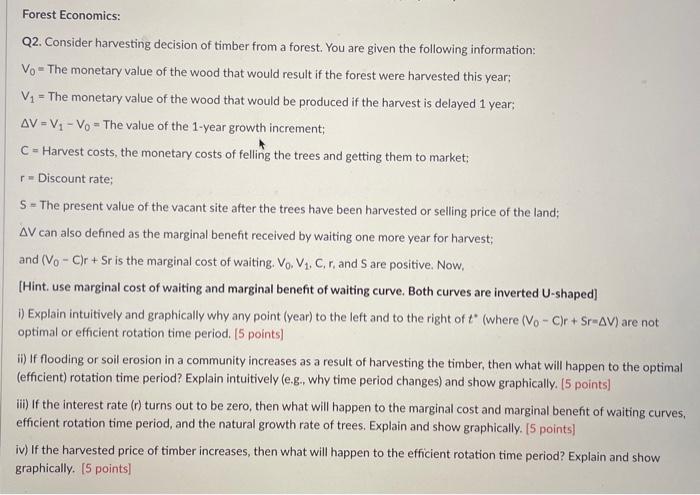Answered step by step
Verified Expert Solution
Question
1 Approved Answer
please help Q2. Consider harvesting decision of timber from a forest. You are given the following information: V0= The monetary value of the wood that
please help 
Q2. Consider harvesting decision of timber from a forest. You are given the following information: V0= The monetary value of the wood that would result if the forest were harvested this year: V1= The monetary value of the wood that would be produced if the harvest is delayed 1 year; V=V1V0= The value of the 1-year growth increment; C= Harvest costs, the monetary costs of felling the trees and getting them to market; r= Discount rate; S = The present value of the vacant site after the trees have been harvested or selling price of the land; V can also defined as the marginal benefit received by waiting one more year for harvest: and (V0C)r+Sr is the marginal cost of waiting. V0,V1,C,r, and S are positive. Now, [Hint. use marginal cost of waiting and marginal benefit of waiting curve. Both curves are inverted U-shaped] i) Explain intuitively and graphically why any point (year) to the left and to the right of t (where (V0C)r+Sr=V) are not optimal or efficient rotation time period. [5 points] ii) If flooding or soil erosion in a community increases as a result of harvesting the timber, then what will happen to the optimal (efficient) rotation time period? Explain intuitively (e.g. why time period changes) and show graphically. [5 points] iii) If the interest rate (r) turns out to be zero, then what will happen to the marginal cost and marginal benefit of waiting curves, efficient rotation time period, and the natural growth rate of trees. Explain and show graphically. [5 points] iv) If the harvested price of timber increases, then what will happen to the efficient rotation time period? Explain and show graphically. [5 points] Q2. Consider harvesting decision of timber from a forest. You are given the following information: V0= The monetary value of the wood that would result if the forest were harvested this year: V1= The monetary value of the wood that would be produced if the harvest is delayed 1 year; V=V1V0= The value of the 1-year growth increment; C= Harvest costs, the monetary costs of felling the trees and getting them to market; r= Discount rate; S = The present value of the vacant site after the trees have been harvested or selling price of the land; V can also defined as the marginal benefit received by waiting one more year for harvest: and (V0C)r+Sr is the marginal cost of waiting. V0,V1,C,r, and S are positive. Now, [Hint. use marginal cost of waiting and marginal benefit of waiting curve. Both curves are inverted U-shaped] i) Explain intuitively and graphically why any point (year) to the left and to the right of t (where (V0C)r+Sr=V) are not optimal or efficient rotation time period. [5 points] ii) If flooding or soil erosion in a community increases as a result of harvesting the timber, then what will happen to the optimal (efficient) rotation time period? Explain intuitively (e.g. why time period changes) and show graphically. [5 points] iii) If the interest rate (r) turns out to be zero, then what will happen to the marginal cost and marginal benefit of waiting curves, efficient rotation time period, and the natural growth rate of trees. Explain and show graphically. [5 points] iv) If the harvested price of timber increases, then what will happen to the efficient rotation time period? Explain and show graphically. [5 points] 
Step by Step Solution
There are 3 Steps involved in it
Step: 1

Get Instant Access to Expert-Tailored Solutions
See step-by-step solutions with expert insights and AI powered tools for academic success
Step: 2

Step: 3

Ace Your Homework with AI
Get the answers you need in no time with our AI-driven, step-by-step assistance
Get Started


